Last updated on March 8th, 2020
Panama, or the Republica de Panama, is a beautiful country of tropical rainforests, small villages, sandy white beaches and the most cosmopolitan international city in Central America. Their Pan-American Highway and 21 airports make travel throughout the country quite easy.
The capital, Panama City, is both a vibrant metropolitan area as well as a gateway to nearby beaches and tropical escapes. Panama is a regional hub of trade, immigration and, above all, tourism. For those who are considering a visit there, here are 70 interesting facts about Panama.
The country of Panama is the isthmus connecting Central America to South America. Bisecting the nation at its narrowest and lowest point is the Panama Canal, providing ships a faster way of traveling from the Atlantic to the Pacific Ocean and back again.
10 Interesting Facts about the Panama Canal
1. The earliest recorded mention of a canal through Panama was made by Charles V, King of Spain and Holy Roman Emperor. In 1534 he wanted a route to be devised that would ease the danger and length of the voyages of Spain’s ships traveling between Peru and Spain. Thomas Jefferson encouraged the Spanish to consider this idea in 1788.
2. The Panama Railway was built by the United States across Panama in 1855. This railway largely determined the route the canal itself would later take.
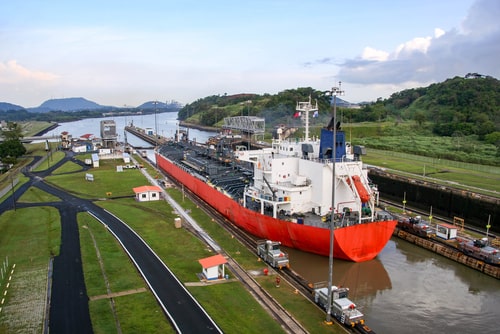
3. A sea level canal system was not feasible in Panama due to its nine-month long rainy season. It would have flooded out the canal.
4. A lock system was devised instead. Two French engineers, Armand Reclus and Lucien Wyre, published a French proposal for the canal in 1877. The French began the original construction in the 1880s but stopped when worker mortality and the rains took too high a cost.
5. The United States took over the initial construction from the French in 1904 and completed the canal ten years later. It officially opened on August 15, 1914, with the U.S. in control of the Canal Zone.
Flag of Panama
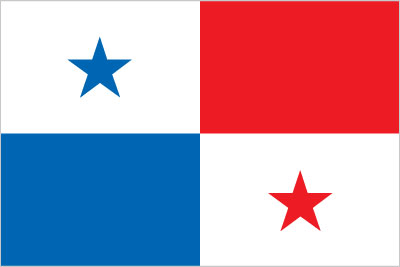
6. There are locks at each end of the canal to lift ships up to Gatun Lake, a man-made lake at 26 meters (85 feet) above sea level, and then back down to the opposite coast.
7. These original locks are 335 meters (110 feet) wide.
8. The 1977 Torrijos-Carter Treaties ceded U.S. control of the Canal Zone back over to the Panamanian government. The two countries controlled it jointly from 1977 to 1999.
9. Control of the Panama Canal passed back into their nation’s hands at midnight on the last day of the 20th century, December 31, 1999.
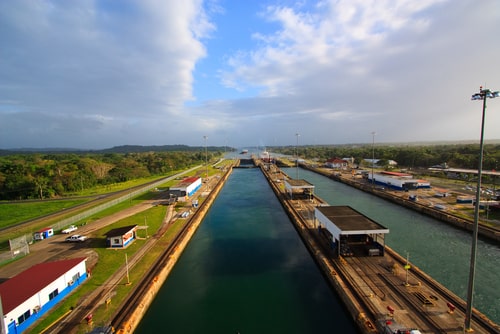
10. On June 26, 2016, the new and expanded third lane of the canal began commercial operations after a long construction period lasting from 2007 until 2016.
Panama’s history
Panama’s history is an ancient one. The native peoples established villages here long before the advent of Spanish and European explorers. Panama has been a colonial settlement, a part of Colombia, and a land many governments wished to control. Today it is an independent nation with a government that is a constitutional democracy.
11. Christopher Columbus visited in 1502 and Balboa arrived to explore the area in 1513.
12. Settled as a colonial area by the Spanish, it became their principal shipping point to and from Central and South America back to Spain in during its colonial days.
13. When Central America revolted against Spain in 1821, Panama joined the already independent country of Colombia. It would then spend the next 82 years struggling to gain its independence from Colombia.
14. When Colombia rejected the United States’ Canal proposal in 1903, Panama finally broke free and declared its independence, which the U. S. immediately recognized in order to back the new government.
15. The U. S. paid Panama $10 million for the Canal Zone and canal rights in perpetuity with an additional per annum of $250,000. Construction began in 1904. The U. S. also wielded considerable influence in Panama’s affairs. By 1955, the per annum had risen to $1,930,000.
16. In September of 1977, President Jimmy Carter and Panama’s General Omar Torrijos signed treaties returning to Panama gradual control of the Canal Zone until it was completely theirs by the end of the century. The treaties also guaranteed Panama’s neutrality in operating the canal and called for U. S. military bases to be phased out.
17. Seven years later, Panama’s first president elected by the people in 16 years was inaugurated in 1984. President Nicholas Ardito Barletta was a puppet of the head of the secret police, General Manuel Noriega.
18. Noriega replaced the president a year later with Vice-President Eric Arturo Delvalle and the U. S. indicted Noriega for drug trafficking in 1988. When Delvalle tried to fire Noriega, the general forced the national assembly to replace him with Manuel Solis Palma. Finally, the assembly named Noriega “maximum leader” in December of 1989 and declared Panama and the United States to be at war.
19. Responding to the death of a U. S. soldier, the U. S. had 24,000 troops seize control of Panama City and attempt to capture Noriega. He surrendered on January 3, 1990, was taken to Miami and was later tried and convicted of drug trafficking. Elections have been held in Panama ever since.
20. Millionaire businessman Ricardo Marinelli was elected president in May 2009 and his Vice-President Juan Carlos Varela succeeded him in May 2014.
Facts about tourism and economy in Panama
When Panama is mentioned many people think of the Panama Canal. While the Canal is an important part of the country’s identity. Panama is much more than its most commercially productive venture (the Panama Canal.)
Agricultural exports plus international banking and trade also flourish here. Tourism is an important part of the nation’s economy and there is much for the visitor to experience and enjoy in this beautiful tropical country.
21. The revenue from the Panama Canal tolls represents a significant portion of the country’s GDP annually (Gross Domestic Product). Since 2010, in fact, Panama’s economy has been Latin America’s second most competitive economy as one of its fastest growing and most well-managed economies.
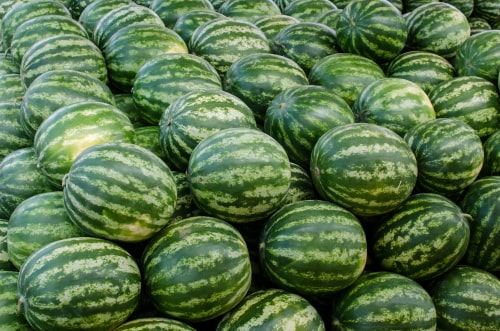
22. Panama exports bananas, pineapples, and watermelons. It also exports gold as well as iron and steel waste. Sugar and shrimp as exported too. Panama’s major trading partners are the United States, Sweden, the Netherlands, Mexico, Costa Rica, Canada, China, and Italy.
23. Panama’s natural resources include its mahogany forests, copper, shrimp industry and the hydro-power it generates from the Rio Chagres and the Rio Chepo. Agricultural products include bananas, coffee, rice, corn, shrimp, sugar cane, livestock, and vegetables.
24. Tourism is growing in Panama. The Tocumen International Airport in Panama City is Central America’s largest and flights connect Panama to all parts of the world.
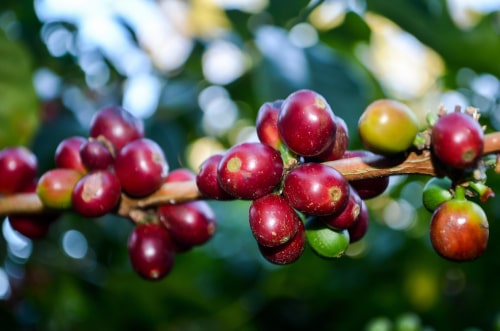
25. The monetary units of Panama are the U. S. dollar and the Balboa. Panama has its own coinage.
26. Panama has attractions for every member of the family and every age group. From history to art and culture; outdoor activities to water and beach sports; to nightlife and dining experiences, Panama has it all.
27. The peninsula of Casco Viejo is a busy colonial neighborhood with historical ruins and cobblestone streets. This is the site of the original 1519 Panama City, today a UNESCO World Heritage Site.
28. The Miraflores Visitors Center at Miraflores Locks — Panama Canal has large observation decks from which to watch the movement of vessels through the canal itself. It also offers exhibition halls, a refreshment stand, a gift shop and a nice restaurant. A historical mural of the tremendous effort it took to build the canal is mounted in the rotunda of the Panama Canal Administration Building and open to the public.
29. The spectacular Biomuseo is itself a work of modern art and houses exhibits that tell the story of how the Isthmus of Panama and its emergence affected the history of the world. It includes the Gallery of Biodiversity, the Panamarama, The Surge Bridge, The Grand Exchange, aquariums, galleries, observation posts and a cafe.
30. The Panama Canal Museum is part of Panama’s Old Town district and is a public non-profit institution. It contains ten permanent exhibits and several temporary ones each year. Additionally, Panama City offers the Panama History Museum, the Museum of Natural Sciences, and the Museum of Colonial Religious Art as well as others.
31. Ecotourism is popular and Panama is home to the most diverse wildlife population of all the countries in Central America. Bird watching is thrilling, with almost 1,000 bird species to observe from the tiniest Volcano Hummingbird to the Harpy Eagle, the largest bird on the continent. Over a third of Panama is Natural Park land. Dolphin Sails and Whale Watching cruises, and Sea Turtle observations are also available.
32. Surfing and snorkeling are popular on the sandy beaches on both the Pacific and the Caribbean coasts of Panama. All the beaches are public property in this country. Visitors also enjoy Coiba National Marine Park, Taboga Island, the Pearl Islands and the Bay of Panama.
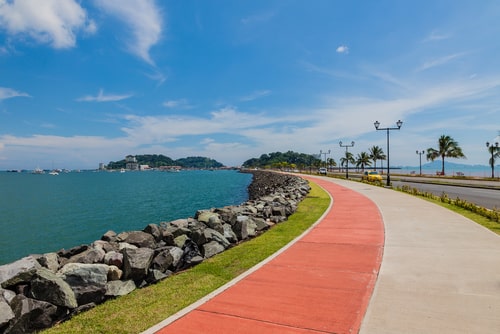
33. Bicycling is popular on the Amador Causeway, a six-kilometer-long path that is bordered by the ocean on both sides. Hiking on any of a number of established trails is popular as well. Summit National Park includes a botanical garden in addition to well-marked paths.
34. Camping, canoeing, and kayaking are all popular in the many National Parks. Most of the rivers, such as the Rio Grande, the Manoni River, and the Chagres are Class II, III, and IV waters.
35. Panama’s Buenaventura Golf Course is arguably the best in all of Latin America. This 18-hole par 72 course was designed by Jack Nicklaus and includes gorgeous views of the Pacific Ocean.
The younger members of the family will be interested in some other attractions and local residents of Panama.
36. Skateboarding is popular with the local people and there are several skate parks in or near Panama City. The Coastal Strip 3 Skatepark and Skatepark Chorrera are open to the public while the Skatepark Punta Chamo is a private one in the Nitro City resort.
37. The Rod Carew Stadium is home to the national Panama Metro professional baseball club. There are eight other professional regional teams in Panama. Baseball is Panama’s national sport. More than 140 Panamanian players have played pro ball in the U.S, including Ron Carew and Carlos Ruiz.
38. The Gamboa Cable Car ride is an aerial car that takes you for a several kilometers-long ride through and above the jungle canopy to the top of Cerro Relado from which you can bird and animal watch as you ride. Frequently spotted are coatimundis, howler monkeys, capybaras, slothes (slow-moving tropical American mammals that hang upside down from the branches of trees using their long limbs and hooked claws), toucans, parrots, and motmots.
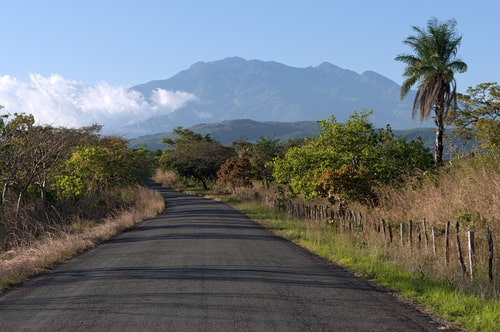
39. The highest point in Panama is the Volcan Baru (a dormant volcano) that is 3,475 meters (11,401 feet) high.
40. There are almost 500 rivers in Panama. Three hundred of them empty into the Pacific Ocean and the rest empty into the Caribbean Ocean.
Continue reading on the next page…
